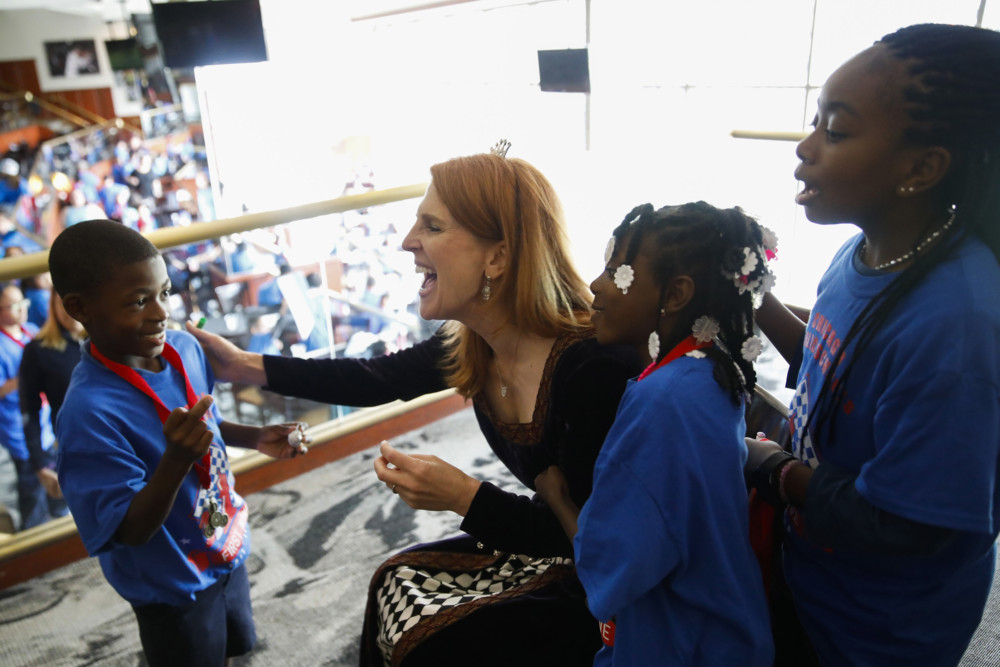By Heidi Stevens
Chicago Tribune
WWR Article Summary (tl;dr) “First Move Chess” is a national program that offers chess curriculum to second- and third-graders as a way to introduce them to the game and help them hone the critical thinking, math, sportsmanship and social skills that go along with it.
CHICAGO
My first encounter with the Chess Lady was in a classroom at Dewey Elementary in Englewood, where she cheerfully explained the Fibonacci sequence to a group of third-graders. (And to me. I hadn’t a clue.)
“Add the first two numbers to get the next number,” she said via video, after the pattern “1, 1, 2, 3, 5, 8, 13, 21” appeared on a screen at the front of the classroom.
My second encounter with the Chess Lady was considerably more festive, though no less numbers-based.
“I cried when I saw her,” Dewey third-grader Demetria Vaughn told me. “I actually touched her, and I was shaking.”
Vaughn was one of 300 Chicago Public Schools students who spent Friday, June 8, at Guaranteed Rate Field for a chess extravaganza, chess arts and crafts, 10 stations of chess lessons and, the piece de resistance, the Chess Lady.
The students in attendance all take part in First Move Chess, a national program that offers chess curriculum to second- and third-graders as a way to introduce them to the game and help them hone the critical thinking, math, sportsmanship and social skills that go along with it.
CPS has been partnering with First Move for five years, and the program is actively used in close to 100 schools this year, said Nichole Matthews, CPS academic competition coordinator.
“I’ve seen chess break down so many barriers,” Matthews told me. “You’re learning the curriculum, you’re learning math, you’re learning history, you’re learning social skills, all while moving pieces around a board.”
Friday’s event was a year-end celebration for students from three schools who’d just completed a year of First Move learning: Mariano Azuela Elementary in Little Village, Pulaski International School in Bucktown and Dewey Elementary.
The kids each received a passport upon arrival. When they’d visited all 10 chess stations and mastered the lessons therein, they were pointed toward an 11th station to receive a medal from none other than the Chess Lady, whom, prior to Friday, they’d only seen on a screen in instructional videos.
“I was screaming, and I gave her a hug because I didn’t even know she was real,” Niciah Washington, a Dewey third-grader, told me. “I thought she might be a fake person. Some people, you see them on YouTube, but they’re not real. But she got on the microphone, and it sounded just like her. I think it’s really her.”
It’s really her, I told Niciah. I checked.
“You did?” she asked. “Does she really have all those chess pieces?”
The Chess Lady takes her fame in stride.
“One of the wonderful things about this program is, as you see, they truly are excited about chess,” she told me.
“They’re excited to see me because they’re excited about chess.”
As is she.
“It’s learning to shake hands before a game,” she said. “It’s critical thinking. It’s learning to play fair. It’s math. I had a child one time say to me, ‘It’s really sneaky learning.’ ”
The day I visited Dewey, I watched groups of four or five students huddle around desks strategizing and collaborating as their teacher, Paige Watkins, walked them through the chess lessons using the videos, workbooks and playing boards provided by First Move. (Matthews said First Move normally charges schools a nominal fee for the materials, but it has waived the cost for CPS.)
“Chess is a calm-down game,” third-grader Kenneth Sims told me the day I visited his classroom. “It’s not a game you rush through. It’s a thinking game. When you feel like having a temper tantrum, chess calms you down.”
Fellow third-grader Khamaria Hudson said chess has improved her reading.
“It helps me focus and go slow,” she said.
Maybe we should all be playing.
“It doesn’t matter whether you’re big or small, rich or poor, black, white or polka-dotted,” the Chess Lady told me. “Chess levels the field. I have teachers who say, ‘I’ve got kids who are playing together who don’t normally play together. They’ve got respect for each other on the chess board.’ And because we teach it in the classroom, rather than an after-school setting that might be more competitive, you see them help each other. ‘You know what? You don’t want to make that move because then I’ll be able to capture you.’ ”
What a lovely foundation. Shake hands. Slow down. Focus. Collaborate. We grown-ups could learn a thing or two from this game and from the Chicago kids who are mastering it.














































































































































































































































































































































































